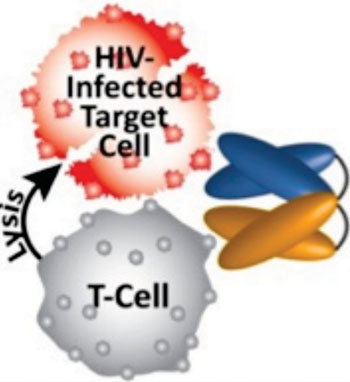Bi-Specific Antibodies Shown to Clear Latent HIV Infections
By LabMedica International staff writers
Posted on 13 Oct 2015
Bi-specific antibodies or DARTS (dual-affinity re-targeting proteins) have been used to eliminate latent HIV-infection from patient samples by redirecting polyclonal T-cells to specifically engage with and kill HIV-infected cells that display HIV antigens on their cell membranes.Posted on 13 Oct 2015
A patient cannot be deemed cured of HIV infection as long as the virus remains hidden (latent) in some of the patient's lymphocytes. To destroy these latent pathogens requires their activation and clearance.

Image: Schematic representation of HIV DART binding to two distinct antigens simultaneously, redirecting the killer T-cells to destroy HIV-1 infected cells (Photo courtesy of Duke University).
Towards this end investigators at Duke University (Durham, NC, USA) and colleagues at the biopharmaceutical company MacroGenics, Inc. (Rockville, MD, USA; www.macrogenics.com) employed DARTS that were engineered by MacroGenics, using HIV-targeting antibodies discovered at Duke University.
They described in the September 28, 2015, online edition of the Journal of Clinical Investigation the application of DARTs that comprised a monovalent HIV-1 envelope-binding (Env-binding) arm that had been derived from broadly binding, antibody-dependent cellular cytotoxicity–mediating antibodies known to bind to HIV-infected target cells that were coupled to a monovalent CD3 binding arm designed to engage cytolytic effector T-cells (referred to as HIVxCD3 DARTs). These DARTs were designed to redirect polyclonal T-cells to specifically engage with and kill Env-expressing cells, including CD4+ T-cells infected with different HIV-1 subtypes, thereby obviating the requirement for HIV-specific immunity.
Using lymphocytes from patients on suppressive antiretroviral therapy, the investigators demonstrated that DARTs mediated CD8+ T-cell clearance of CD4+ T-cells that were superinfected with the HIV-1 strain JR-CSF or infected with autologous reservoir viruses isolated from HIV-infected–patient resting CD4+ T-cells. Moreover, DARTs mediated CD8+ T cell clearance of HIV from resting CD4+ T-cell cultures following induction of latent virus expression.
“This is a great opportunity for MacroGenics to expand our DART platform for therapeutics applications beyond oncology and autoimmune disorders and into infectious diseases,” said Dr. Scott Koenig, president and CEO of MacroGenics. “We are encouraged by our proof-of-concept studies that show HIV DART molecules to be potent immunotherapeutic agents with the potential to reduce HIV reservoirs in patients.”
“Because we are targeting a region of the virus envelope that appears in all mutations of the virus, we think it will make it much easier to be broadly utilized—at least from our laboratory data,” said senior author Dr. Guido Ferrari, associate professor of surgery, molecular genetics, and microbiology at Duke University. “These DART molecules will facilitate the recognition. We are eager to see how this translates to human studies.”
Related Links:
Duke University
MacroGenics, Inc.













